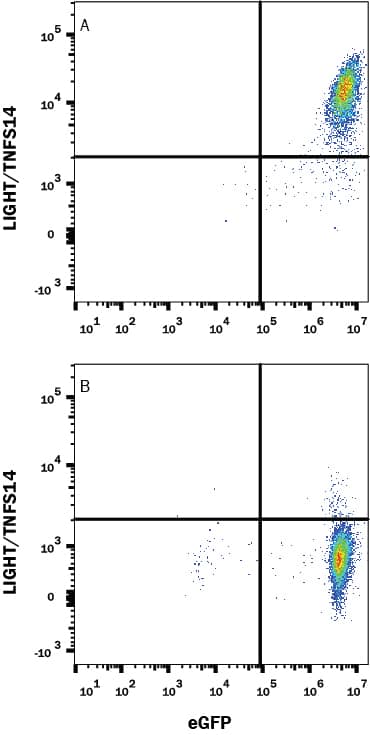Mouse LIGHT/TNFSF14 Antibody
R&D Systems, part of Bio-Techne | Catalog # MAB17943


Conjugate
Catalog #
Key Product Details
Species Reactivity
Mouse
Applications
CyTOF-ready, Flow Cytometry
Label
Unconjugated
Antibody Source
Monoclonal Rat IgG1 Clone # 906909
Product Specifications
Immunogen
Mouse myeloma cell line NS0-derived recombinant mouse LIGHT/TNFSF14
Asp72-Val239
Accession # Q9QYH9
Asp72-Val239
Accession # Q9QYH9
Specificity
Detects mouse LIGHT/TNFSF14 in direct ELISAs.
Clonality
Monoclonal
Host
Rat
Isotype
IgG1
Scientific Data Images for Mouse LIGHT/TNFSF14 Antibody
Detection of LIGHT/TNFSF14 in HEK293 Human Cell Line Transfected with Mouse LIGHT/TNFSF14 and eGFP by Flow Cytometry.
HEK293 human embryonic kidney cell line transfected with either (A) mouse LIGHT/TNFSF14 or (B) irrelevant transfectants and eGFP was stained with Rat Anti-Mouse LIGHT/TNFSF14 Monoclonal Antibody (Catalog # MAB17943) followed by APC-conjugated Anti-Rat IgG Secondary Antibody (Catalog # F0113). Quadrant markers were set based on control antibody staining (Catalog # MAB005). View our protocol for Staining Membrane-associated Proteins.Applications for Mouse LIGHT/TNFSF14 Antibody
Application
Recommended Usage
CyTOF-ready
Ready to be labeled using established conjugation methods. No BSA or other carrier proteins that could interfere with conjugation.
Flow Cytometry
0.25 µg/106 cells
Sample: HEK293 Human Cell Line Transfected with Mouse LIGHT/TNFSF14 and eGFP
Sample: HEK293 Human Cell Line Transfected with Mouse LIGHT/TNFSF14 and eGFP
Formulation, Preparation, and Storage
Purification
Protein A or G purified from hybridoma culture supernatant
Reconstitution
Reconstitute at 0.5 mg/mL in sterile PBS. For liquid material, refer to CoA for concentration.
Formulation
Lyophilized from a 0.2 μm filtered solution in PBS with Trehalose. *Small pack size (SP) is supplied either lyophilized or as a 0.2 µm filtered solution in PBS.
Shipping
Lyophilized product is shipped at ambient temperature. Liquid small pack size (-SP) is shipped with polar packs. Upon receipt, store immediately at the temperature recommended below.
Stability & Storage
Use a manual defrost freezer and avoid repeated freeze-thaw cycles.
- 12 months from date of receipt, -20 to -70 °C as supplied.
- 1 month, 2 to 8 °C under sterile conditions after reconstitution.
- 6 months, -20 to -70 °C under sterile conditions after reconstitution.
Background: LIGHT/TNFSF14
Long Name
TNF Ligand Superfamily Member 14
Alternate Names
CD258, TNFSF14
Gene Symbol
TNFSF14
UniProt
Additional LIGHT/TNFSF14 Products
Product Documents for Mouse LIGHT/TNFSF14 Antibody
Product Specific Notices for Mouse LIGHT/TNFSF14 Antibody
For research use only
